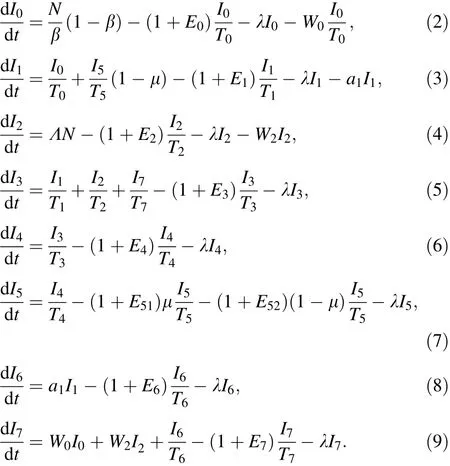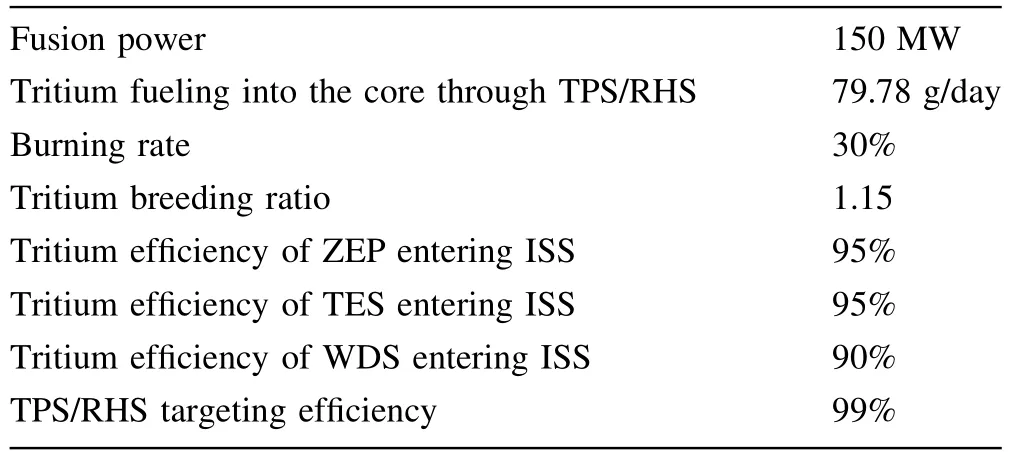Preliminary analysis of tritium fuel cycle in Z-pinch-driven fusion– fission hybrid reactor
2018-06-27YongGangMoZhiLinChenHongHuSongYangYangJingWuDongZhang
Yong-Gang Mo•Zhi-Lin Chen•Hong-Hu Song•Yang Yang•Jing Wu•Dong Zhang
1 Introduction
In the 1950s,the concept of the fusion– fission hybrid reactor was introduced.There are many advantages of this reactor,such as waste management and fuel production[1].Recently,several different conceptual designs of fusion–fission hybrid reactors have been developed,e.g.,magnetic and inertia confinements[2–4].One typical inertia confinement reactor is the In-Zinerator,proposed by the Sandia National Laboratory [4–6].The China Academy of
This work was supported by the National Natural Science Foundation of China(No.11505165).Engineering Physics has also provided a conceptual design of a Z-pinch-driven fusion– fission hybrid reactor(Z-FFR)[7–9].In Z-FFR,the main function of the fusion part is to provide high-energy neutrons,while the fission zone generates power and the tritium breeding blanket produces tritium.As the important fuel of fusion,tritium is extremely scarce in nature.The problems relating to tritium are similar to those of fusion reactors,such as management,safety issues,and the accountability of tritium[10–13].
In order to make efficient use of tritium,achieve tritium self-sufficiency,and evaluate the radiation risks of tritium in a Z-FFR,a detailed analysis of the tritium fuel cycle is essential.Attaining tritium self-sufficiency is also of great importance.
In this paper,a preliminary analysis of Z-FFR is performed and a tritium mass flow model was established.In particular,the primary subsystems of tritium self-sufficiency were identified.The circulation loop was the key issue in the tritium self-sufficiency analysis.Based on the mean residence time method and design parameters of Z-FFR,the tritium content in subsystems was calculated.
In the steady state of the Z-FFR,the tritium inventory of each subsystem based on this model was computed.Then,the tritium self-sufficiency judgment and critical conditions were given.Finally,the tritium self-sufficiency conditions were analyzed in a reasonable range for three important parameters,namely the burning rate,tritium breeding ratio(TBR),and extraction efficiency of the isotope separation system.
2 Theory
2.1 Calculation model
The tritium fuel cycle system of the Z-FFR is shown in Ref.[14].According to the conceptual design,the tritium cycle system was divided into eight subsystems,including the core,which consisted of a fusion core, fission zone,and tritium breeding zone,Z-pinch exhaust processing system(ZEP),tritium extracting system(TES),isotope separation system(ISS),atmosphere detrition system/vent detrition system(ADS/VDS),water detrition system(WDS),tritium storage system(TSS),and target preparation system/RTLhandling system(TPS/RHS).The tritium fuel cycle process of our model is shown in Fig.1.
In the model,neutrons produced by the deuterium–tritium(DT)fusion reaction in the fusion core are introduced into the tritium breeding zone to breed tritium.After DT ignition,the ZEP recycles the unburned tritium,while the TES extracts tritium from the tritium breeding blanket,and WDS handles the tritiated water.Afterwards,the impure tritium is introduced into ISS for isotope separation and the separated tritium is stored in TSS.The target preparation and equipment of the tritium fuel are obtained by TPS and RHS,respectively.Then,it ultimately produces a tritium cycle.
In Fig.1,the solid line represents the main circulation loop leading to tritium self-sufficiency.Since the tritium recovery had a certain time lag from the start of reactor,the analysis below was computed under the assumption of steady tritium self-sufficiency.
2.2 Calculation method
Based on the principle of mass conservation and the mean residence time method[15–17],we established a theoretical analysis equation of the tritium cycle system to simplify the calculation.Tritium losses of the TPS/RHS and TSS were not considered.
2.2.1 Tritium flow analysis
In the consumption and proliferation of tritium,tritium loss by transmission(tritium that is retained in materials and diffused into environment)and tritium loss by decay(T1/2=12.3 years)should be taken into consideration[16].The tritium entering the environment can be estimated backwards from the safety limits.However,compared with the retention,this part is negligible.Tritium loss in the waste is relatively difficult to estimate.
In our description equations of the model,the tritium flow was divided into four directions:①the effective tritium transferring between subsystems;②the consumption tritium in fusion and breeding tritium;③the radioactive loss tritium;and④the nonradioactive loss tritium.Therefore,the tritium mass flow of each subsystem was obtained.
Effective tritium is the tritium that can be totally introduced into the next subsystem.The separate tritium loss in each subsystem was taken into consideration.The parameters in our calculations are listed in Table 1.
Based on the theory mentioned above,the tritium mass flow equations for each subsystem given in Eqs.(1)–(9).


Fig.1(Color online)Tritium flow of subsystems in Z-FFR

Table 1 Parameters in calculations

2.2.2 Tritium self-sufficiency judgment method
The fusion power of the Z-FFR stays constant in steady state.Tritium self-sufficiency is a prerequisite for longterm operations.Therefore,the amount of recovery and breeding tritium is required to be higher than the normal supply of TPS/RHS.Therefore,the tritium self-sufficiency is determined by

where Iburningand a are the tritium combustion of the core and tritium injection efficiency,respectively.
The initial tritium is stored in the TSS.When the hybrid reactor starts to work,tritium in the TSS is gradually reduced to a minimum amount that can maintain the normal operation of the TPS/RHS and core.At the same time,the breeding and recycling tritium provide the consumption.Therefore,in the steady state,it is reasonable to determine the tritium self-sufficiency by comparing the tritium flow of the ISS with the consumption of the TPS/RHS.
2.3 Parameters
As the tritium processing system in the Z-FFR is similar to a pure fusion reactor,some parameters of the tritium systems test assembly(TSTA)were applied in our calculations.The input parameters are listed in Tables 2 and 3 by referring to Ref.[14,18–21].As the fission zone in the Z-FFR produces extra neutrons,it is relatively easier to make the TBR reach 1.15 comparing with international thermonuclear experimental reactor(ITER).Generally,the operation temperature of the ISS is very low and nonradioactive loss can be ignored.
3 Results and discussion
3.1 Tritium in subsystems
The total tritium of each subsystem consisted of tritium loss and effective tritium.Therefore,it was expected that the tritium handling capacity of each subsystem should be marginally higher than the effective tritium mass flow.The effective tritium mass and effective tritium mass flows are listed in Table 4,which can be used as a reference for the Z-FFR design.
3.2 Critical requirement of tritium self-sufficiency
In the design of the Z-FFR[14],the burning rate was estimated at 30%,while TBR and extraction efficiency were set to 1.15 and 95%,respectively,to meet the requirements of tritium self-sufficiency.In our model and calculation,the limited condition for every parameter was calculated.The results showed that the burning rate or extraction efficiency must be greater than 23.9 and 87%,respectively.As the burning rate is supposed to reach 40%,it is not possible for the extraction efficiency to be 100%.The burning rate changed from 23.9 to 40%and the extraction efficiency changed from 87 to 99%.

Table 2 Tritium system parameters

Table 3 Core and subsystem efficiency of the Z-FFR
The critical requirements of the extraction efficiency,burning rate,and TBR are shown in Figs.2,3,and 4.
As shown in Figs.2,3,and 4,the three crucial parameters of the Z-FFR were considered under the assumption of tritium self-sufficiency.The results indicated that the design leaves a certain margin for tritium self-sufficiency.As the fusion power stayed constant,the general principle that a higher burning rate is better was calculated quantitatively.The increase in the burning rate led to a decrease in tritium that was needed for injection into the core and managed in the subsystems.
The goal of the TBR is to attain tritium self-sufficiency.A higher TBR can be used to lower the requirements of the other parameters,or it can produce more tritium than isneeded for self-sufficiency and further used to supply another reactor.However,improvements in the tritium treatment capacity of subsystems are also required.The security risk of the Z-FFR will increase due to excessive tritium over the entirety of the tritium cycle.

Table 4 Z-FFR tritium distributions and tritium flow

Fig.2(Color online)Critical requirements of the tritium selfsufficiency at typical burning rates

Fig.3(Color online)Critical requirements of tritium self-sufficiency at typical extraction efficiencies

Fig.4(Color online)Critical requirements of tritium selfsufficiency
In the analysis,the radioactive and nonradioactive losses of subsystems were taken into account,except for the TSS and TPS/RHS.There are still uncertainties caused by the model description and other differences in specific details.The unknown parameters of the TSS and TPS/RHS in the Z-FFR still need to be addressed in the future.
Since the TBR of the Z-FFR can be relatively high,the calculations and complementary relationship of tritium self-sufficiency shown in Figs.2,3,and 4 provide good references for Z-FFR design.
4 Conclusion
The preliminary analysis model of the Z-FFR tritium cycle system based on the mean residence time method was established,making it available for calculations of the effective tritium and tritium mass flow in the steady state.The tritium self-sufficiency was also determined to analyze the critical requirements for the Z-FFR.
The calculation of the tritium fuel cycle in Z-FFR was completed.The effective tritium and tritium mass flow of some subsystems were obtained by employing the design parameters in steady state.It was found that the ZEP contained the most effective tritium among the subsystems,followed by the TES,ISS,and WDS.However,the effective tritium mass flow of ISS was the highest,followed by the TSS,core,ZEP,TES,and WDS.There are three crucial parameters for the tritium self-sufficiency,the burning rate,extraction efficiency,and TBR.It is very important to enhance the performance of all these factors to achieve the tritium self-sufficiency in the Z-FFR.In addition,the tritium mass distribution of subsystems will provide useful information for tritium safety analyses.
1.J.Freidberg,P.Finck,C.Bolton et al.,Research needs for fusion– fission hybrid systems.Report of the research needs workshop(ReNeW),Gaithersburg,Maryland,2009
2.T.A.Mehlhorn,B.B.Cipiti,C.L.Olson et al.,Fusion– fission hybrids for nuclear waste transmutation:a synergistic step between Gen-IV fission and fusion reactors.Fusion Eng.Des.83,948–953(2008).https://doi.org/10.1016/j.fusengdes.2008.05.003
3.E.I.Moses,A sustainable nuclear fuel cycle based on laser inertial fusion energy.Fusion Sci.Technol.56,547–565(2009).https://doi.org/10.13182/FST09-34
4.B.B.Cipiti,V.D.Cleary,J.T.Cook et al.,Fusion transmutation of waste:design and analysis of the in-zinerator concept.Sandia National Laboratories.To be published SAND report,SAND,2006
5.L.El-Guebaly,B.Cipiti,P.H.Wilson et al.,Engineering issues facing transmutation of actinides in Z-pinch fusion power plant.Paper presented at the 17th ANS topical meeting on fusion energy,Albuquerque,NM,13–15 Nov 2006
6.M.Sawan,L.El-Guebaly,P.Wilson,Three-dimensional nuclear assessment for the chamber of Z-Pinch power plant.Paper presented at the 17th ANS topical meeting on fusion energy,Albuquerque,NM,13–15 Nov 2006
7.X.J.Peng,Z-pinch fusion– fission hybrid reactor——the energy technology road with great competitive power.J Southwest Univ.Sci.Technol.4,002(2010).https://doi.org/10.3969/j.issn.1671-8755.2010.04.001.(in Chinese)
8.X.J.Peng,Z.Wang,Conceptual research on Z-pinch driven fusion– fission hybrid reactor.High Power Laser Part.Beams 26,090201(2014).https://doi.org/10.11884/HPLPB201426.090201.(in Chinese)
9.J.M.Ma,H.B.Guo,Z.Y.Liu et al.,Neutronic analysis of Z-pinch driven fusion– fission hybrid reactor blanket.High Power Laser Part.Beams27,205–210 (2015).https://doi.org/10.11884/HPLPB201527.016002.(in Chinese)
10.T.Tanabe,Tritium handling issues in fusion reactor materials.J.Nucl.Mater.417,545–550(2011).https://doi.org/10.1016/j.jnucmat.2010.12.112
11.T.Tanabe,Tritium issues to be solved for establishment of a fusion reactor.Fusion Eng.Des.87,722–727(2012).https://doi.org/10.1016/j.fusengdes.2012.02.009
12.B.Bornschein,C.Day,D.Demange et al.,Tritium management and safety issues in ITER and DEMO breeding blankets.Fusion Eng. Des. 88, 466–471 (2013). https://doi.org/10.1016/j.fusengdes.2013.03.032
13.C.Day,T.Giegerich,The direct internal recycling concept to simplify the fuel cycle of a fusion power plant.Fusion Eng.Des.88,616–620(2013).https://doi.org/10.1016/j.fusengdes.2013.05.026
14.Z.H.Li,H.W.Huang,Z.Wang et al.,Conceptual design of Z-pinch driven fusion– fission hybrid power reactor.High Power Laser Part.Beams 26,14–20(2014).https://doi.org/10.11884/HPLPB201426.100202.(in Chinese)
15.B.Deng,J.Huang,Mean residence time method of tritium inventory calculation.Fusion Eng.Des.55,359–364(2001).https://doi.org/10.1016/S0920-3796(01)00180-6
16.M.A.Abdou,E.L.Vold,C.Y.Gung et al.,Deuterium-tritium fuel self-sufficiency in fusion reactors.Fusion Technol.9,250–285(1986).https://doi.org/10.13182/FST86-1
17.M.Y.Ni,Research on Fuel Cycle and Tritium Resource Sustainability for Fusion Reactor(University of Science and Technology of China,Hefei,2013).(in Chinese)
18.J.L.Anderson,The status of tritium technology development for magnetic fusion energy.Paper presented at the 5th topical meeting on technology of fusion energy,Knoxville,TN,USA,26 April 1983
19.C.L.Talcott,J.L.Anderson,R.V.Carlson et al.,Three tritium systems test assembly(TSTA)off-loop experiments.Paper presented at symposium on fusion engineering,Hyannis,MA,USA,11 Oct 1993
20.J.L.Anderson,J.R.Bartlit,The development of tritium technology at the tritium systems test assembly.Paper presented at the 12th symposium on fusion technology,Juelich,F.R.Germany,13 Sept 1982
21.H.L.Chen,L.Pan,Z.Lv et al.,Tritium fuel cycle modeling and tritium breeding analysis for CFETR.Fusion Eng.Des.106,17–20(2016).https://doi.org/10.1016/j.fusengdes.2016.02.100
杂志排行
Nuclear Science and Techniques的其它文章
- Gamma irradiation-induced effects on the properties of TiO2 on fluorine-doped tin oxide prepared by atomic layer deposition
- Annual effective dose values from137Cs activity concentrations in soils of Manisa,Turkey
- Investigation of high-temperature-resistant rhenium–boron neutron shields by experimental studies and Monte Carlo simulations
- Monte Carlo simulation of incident electrons passing through thin metal layer
- Preparation and characterization of Bi2O3/XNBR flexible films for attenuating gamma rays
- Investigation of SPECT/CT cardiac imaging using Geant4
